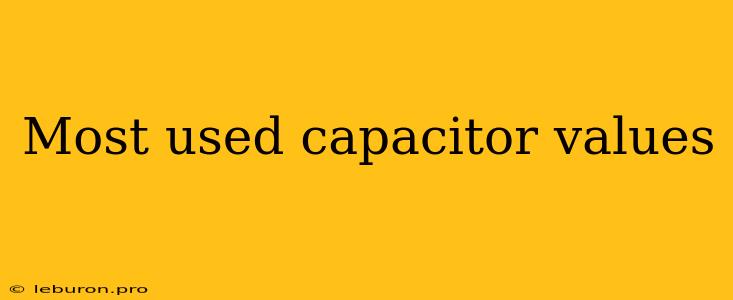Capacitors are essential components in electronic circuits, playing a crucial role in filtering, smoothing, and storing energy. They are widely used in various applications, from simple circuits to complex systems. Understanding the most used capacitor values is crucial for engineers and hobbyists alike, as it allows for efficient circuit design and component selection. This article delves into the most common capacitor values, exploring their applications and factors influencing their usage.
Common Capacitor Values and Their Applications
Capacitors are available in a wide range of values, measured in farads (F). However, certain values are more prevalent due to their frequent use in specific applications. Here's a breakdown of the most used capacitor values and their typical roles:
Small Capacitance Values (pF - nF)
-
10 pF, 22 pF, 47 pF, 100 pF, 220 pF, 470 pF: These values are commonly used in high-frequency circuits, such as oscillators, filters, and coupling circuits. For example, a 100 pF capacitor might be found in a radio frequency (RF) amplifier to block DC while allowing AC signals to pass.
-
1 nF, 2.2 nF, 4.7 nF, 10 nF, 22 nF, 47 nF: These values are prevalent in a variety of applications, including timing circuits, bypass capacitors, and decoupling filters. For instance, a 10 nF capacitor might be used as a bypass capacitor on a microcontroller's power supply to filter out noise and provide a stable voltage.
Medium Capacitance Values (µF - mF)
-
1 µF, 2.2 µF, 4.7 µF, 10 µF, 22 µF, 47 µF: These values are commonly used in filtering, smoothing, and energy storage applications. A 10 µF capacitor might be employed in a power supply filter to smooth out the output voltage or in a DC-to-DC converter for energy storage.
-
100 µF, 220 µF, 470 µF, 1000 µF: These values are prevalent in larger filtering and smoothing applications, such as in audio amplifiers and power supplies. A 470 µF capacitor might be used in a speaker crossover network to filter out high frequencies and provide a smoother bass response.
-
1 mF, 2.2 mF, 4.7 mF, 10 mF: These values are frequently used in applications that require larger energy storage capacity, such as backup power systems and electric vehicles. A 10 mF capacitor might be used in a backup power system to provide temporary power in case of a power outage.
Large Capacitance Values (F)
- 1 F, 2.2 F, 4.7 F, 10 F: These values are relatively uncommon but are used in high-power applications, such as energy storage in electric vehicles and hybrid vehicles. A 1 F capacitor might be used in a hybrid electric vehicle to store energy from regenerative braking.
Factors Influencing the Choice of Capacitor Values
The choice of capacitor values depends on several factors, including:
-
Application: Different applications require different capacitance values. For example, a high-frequency oscillator might require a small capacitor, while a power supply filter might require a larger capacitor.
-
Voltage Rating: Capacitors have a maximum voltage rating that they can withstand. It's crucial to choose a capacitor with a voltage rating exceeding the expected voltage across its terminals.
-
Tolerance: The tolerance of a capacitor specifies the allowable deviation from its nominal value. Higher tolerances generally lead to lower cost but can affect circuit performance.
-
Temperature Coefficient: The temperature coefficient indicates how a capacitor's capacitance changes with temperature. This factor is important in applications where temperature variations are significant.
-
ESR (Equivalent Series Resistance): This parameter represents the internal resistance of the capacitor. Lower ESR is preferred for applications requiring high current or fast switching.
-
Leakage Current: Leakage current is the current that flows through the capacitor even when no voltage is applied. Lower leakage current is desirable in applications where low power consumption is critical.
-
Size and Physical Characteristics: The size and physical characteristics of a capacitor can be significant factors in certain applications, especially where space is limited.
Conclusion
Understanding the most used capacitor values and the factors influencing their selection is essential for effective circuit design. Knowing the typical applications of different capacitance ranges allows for choosing the appropriate components for various needs. By considering the voltage rating, tolerance, temperature coefficient, ESR, leakage current, and physical characteristics, engineers and hobbyists can select the best capacitor values for optimal performance and reliability in their projects.
